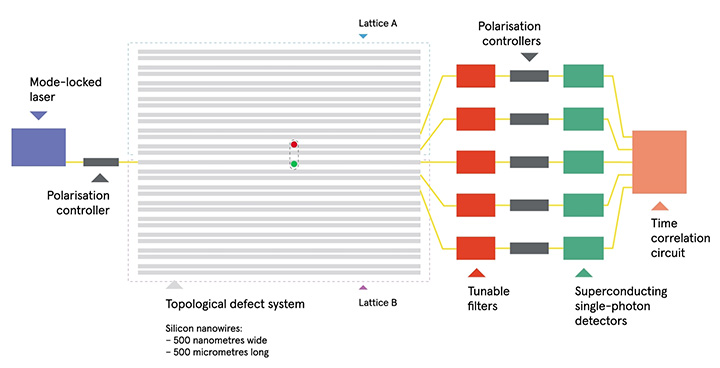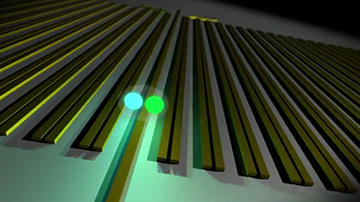![]()
Andrea Blanco-Redondo of the University of Sydney Nano Institute led research exploring topological protection for correlated biphoton states, which could clear one hurdle for photons as quantum information carriers. [Image: Jayne Ion/University of Sydney]
Some researchers in quantum computing look to pairs or ensembles of entangled photons as the best candidates for information-carrying quantum bits (qubits). But entangled photonic quantum states are skittish things, prone to evaporate in imperfect, real-world devices built to meaningful scale. How can the quantum information in photonic qubits be protected long enough to do useful work in a real quantum computer?
One answer could lie in the emerging discipline of topological photonics. A group of researchers in Australia and Israel, led by OSA member Andrea Blanco-Redondo of the University of Sydney Nano Institute, has now experimentally demonstrated a platform for extending “topological protection” to delicate correlated biphoton states—and shown how the platform might be used to build robust logic gates for quantum computing (Science, doi: 10.1126/science.aau4296).
Sensitive to imperfections
One of the attractions of photons as qubit candidates is that they are largely immune to the thermal and electromagnetic noise that can bedevil other quantum systems, such as trapped-ion and superconductor platforms. But photonic qubits have their own vulnerabilities. Notably, they’re prone to potential losses and other errors due to scattering as the photons run up against fabrication imperfections.
Thus, while photons have excelled in the lab in proof-of-principle demonstrations of entanglement, it’s been hard to envision how they might be made to work in a practical quantum device, where at least some fabrication defects are unavoidable. Increasingly, however, the physics of topology—which captured the 2016 Nobel Prize for its pioneers in condensed-matter physics—has seemed to hold one key to solving this photonic-qubit quandary.
Protection in topology
![]()
One recent example of a topological photonic system, published in February 2018, was a topological-insulator laser demonstrated by a team at The Technion and CREOL. [Image: S. Wittek (CREOL) and M.A. Bandres (Technion)]
Topological systems involve materials that, by virtue of the details of their underlying symmetry, possess unusual physical characteristics, best exemplified by so-called topological edge states. In the realm of photonics, these edge states have been leveraged to create exotic proof-of-principle quantum devices such as chips that steer single photons around corners, and lasers that send light in one direction around the edges of an array of microresonators.
Another key feature stoking interest in “topologically nontrivial” photonic systems is that they are “robust to disorder.” For example, a topological-insulator laser confronting a material defect simply detours around it, and then happily continues on its way around the device perimeter.
That has raised the prospect that this shroud of topological protection could be thrown around single and entangled photons in quantum computers and devices, to keep them safe from losing information to scattering and fabrication imperfections. But experiments thus far in topological protection of photons have generally involved only single photons—not the entangled photon pairs or ensembles required for quantum information systems.
Silicon nanowire array
To extend topological protection to a multiphoton quantum state, Blanco-Redondo’s team—which also included Bryn Bell and OSA Fellow Ben Eggleton at the University of Sydney, and Dikla Oren and OSA Fellow Mordechai Segev at The Technion, Israel—began with a platform that, in previous work, they had shown could produce a topological edge state.
The platform consists of a 1-D array of silicon nanowires with alternating short and long gaps, which creates a structure known as a Su-Schrieffer-Heeger (SSH) lattice. By introducing a “long-long” defect in the middle of the lattice, the team coaxed the structure into displaying topological edge-state behavior and topological protection at the interface between the two-sides of the lattice.

The team’s experimental setup involves a lattice of silicon nanowires with a central defect, which creates an “edge state” that provides topological protection for paired photons traveling down the central waveguide. [Image: Rhys Holland & Sebastian Zentilomo/University of Sydney]
The researchers next pumped light from a picosecond 1550-nm pulsed laser into the waveguide at the center of the lattice. The pump pulses generated correlated signal and idler photons via a spontaneous four-wave mixing (SFWM) process; those photons were filtered, collected in superconducting single-photon detectors, and analyzed at the end of the line to establish correlation between the photons’ quantum states.
Testing for topological protection

Artists’ rendering of correlated photons in the nanowire lattice. [Image: Sebastian Zentilomo/University of Sydney]
Finally, with the presence of correlated biphotons established, the team got down to testing whether the system could provide topological protection for the quantum states of those photon pairs. To do so, the researchers introduced random disorders into the SSH lattice and tested whether the quantum states of the biphotons were preserved.
They found that the correlation and quantum state of the biphotons—which would have been scattered and lost across a uniform, topologically trivial lattice—held up well even amid fairly high levels of lattice disorder in the SSH system. The researchers also demonstrated experimentally how several of these lattices, put together, could form “a key building block” to construct entangled quantum systems with topological protection. And they showed how such entangled systems might be used to create a simple two-qubit logic gate for quantum computing.
Toward photonic quantum gates
Blanco-Redondo, in a press release accompanying the work, suggested that the study results offer “a pathway to build robust entangled states for logic gates using protected pairs of photons.” The team is now working on improving the platform, toward the goal of building such quantum gates. The effort, if successful, could provide a boost to the prospects for photons as quantum information carriers in real-world applications.
